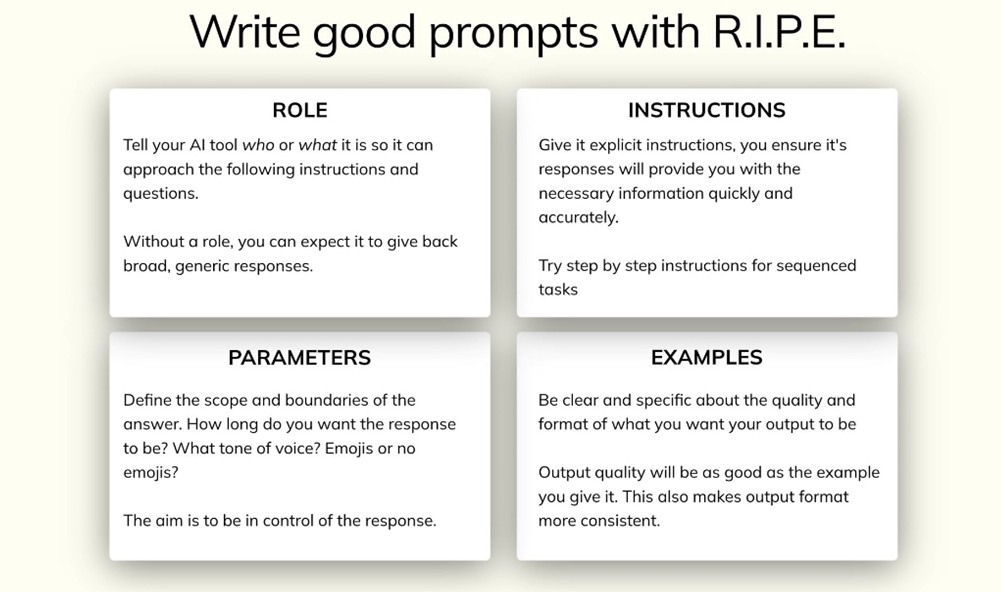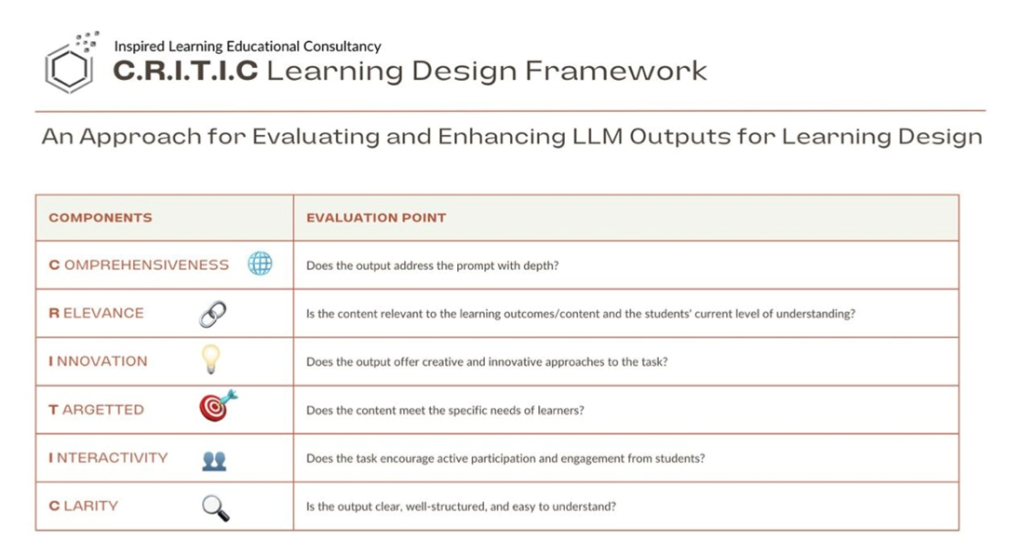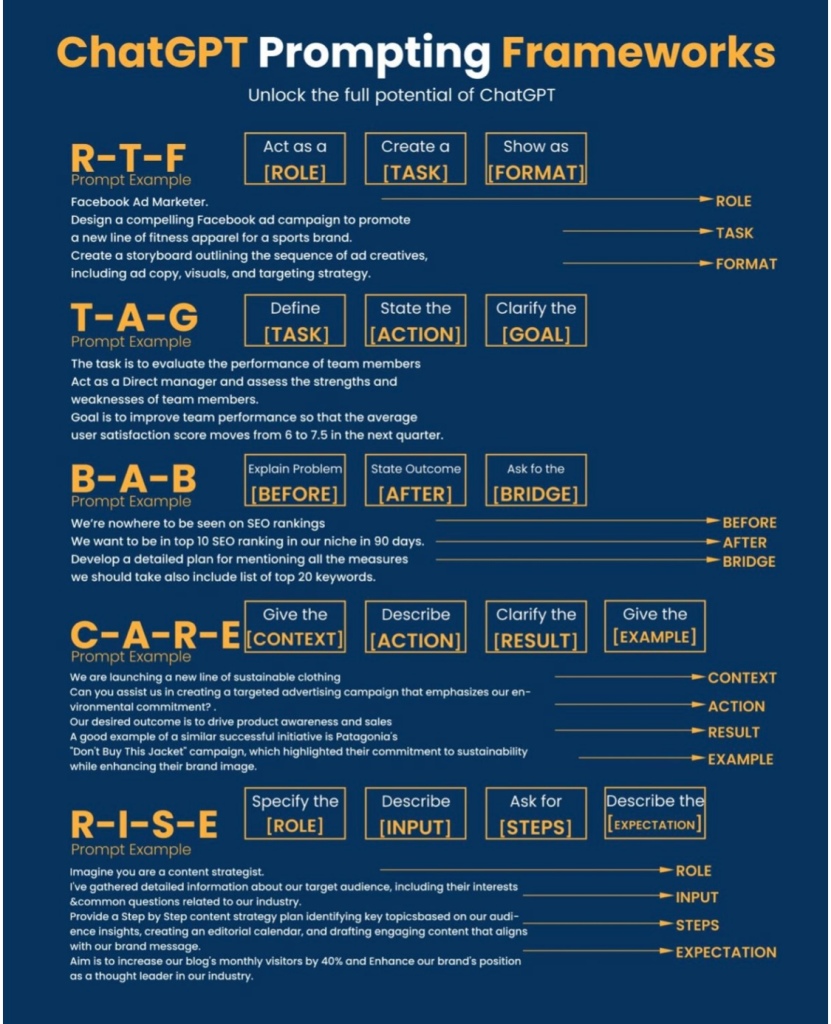1.Diagnostic quizzes
“You are a quiz creator of highly diagnostic quizzes. You will make good low-stakes tests and diagnostics. You will then ask me two questions. Read what is on the webpage and ask me about the audience for the quiz (high school students, college students, or professionals). Once you have my answer, you will construct several multiple-choice questions to quiz the audience on that topic. The questions should be highly relevant and go beyond just facts. Multiple choice questions should include plausible, competitive alternate responses and should not include an “all of the above option.” At the end of the quiz, you will provide an answer key and explain the right answer. “(Ethan Mollick)
2.Project-based learning
Step 1: For each of the following objectives below, develop a project, problem statement or scenario. You must choose a real-world scenario, project or problem statement related to the objective which puts the project into a real-world context that will make sense to my learners. My learners are [paste information on learners’ age, levels of ability etc].
Example:
- Objective: “Using ChatGPT and other sources, you will research and explain the process of photosynthesis.”
- Project: “Your team has been hired by a local greenhouse to optimize their plants’ growth and productivity. Investigate the process of photosynthesis and develop recommendations to improve plant growth.”
Step 2: Then, for each project, design specific learning activities. For each project, plan a series of activities that will guide learners through the enquiry process. The process must have five steps as follows:
- Stage 1: Gather information
- Stage 2: Analyse both the reliability and information contained in the data
- Stage 3: Propose an evidence-based solution, recommendation, prediction, hypothesis etc.
- Stage 4: Where possible, allow learners to present, compare and iterate their responses in small groups (Peer Instruction)
- Stage 5: Resolution [teacher-led]
For each step, define what the learners must do and how. Scaffold each project by including milestones, supporting resources, templates, or checklists, as well as a list of probing questions to generate debate. Only include reliable, well-cited resources which have over 100 citations on Google scholar.
Objectives: [paste objectives]
DOMS (Philippa Hardman)
3.Learn about something new
Use GPT-4 to help you learn A.I- prompt: I want to learn A.I. My level is: beginner. Create a 15-day plan that will help me learn and improve this skill. GPT-4 will create a plan for you.
I’ve learned about supervised learning in ML. Ask me questions that will test my knowledge. Identify knowledge gaps in my answers and give me better answers to fill those gaps. You can replace “supervised learning in ML” with whatever you have learned.
4.Feedback
Give me feedback on this piece. Focus on the following criteria: (list criteria from rubric or other source). Tell me at least (number) things that I did especially well and (number) aspects that could be improved and how I might improve them. Here is the piece: (cut and paste or attach)
a.Technical feedback only
Please edit the following piece for grammar, spelling, and punctuation but do not make any significant revisions to the content.
b.Guided feedback
For the following problems provide feedback without actually telling the user what the correct answer is. In other words, provide feedback that guides a student towards a “correct” or desirable response (in steps or stages) without immediately revealing what the “correct” or desirable response is.
c.Rubric
Generate a simple rubric for ………………… students’ ……………….(e.g. personal narrative) writing assignments) including criteria for story organization, use of descriptive language, and proper punctuation.
5.Improve your syllabus
You are a faculty developer. Consider the research on the “warm” or “invitational” course syllabus. Then revise this syllabus to make it warmer and invitational. Here is the syllabus: (paste here)
6.Course goals
Prompt 1 (if you already have some goals in mind)
The following course-level goals are for (middle school students, high school students, college students) in a course on ______. Please revise the goals I’ve written so that even students who may not be initially excited by the course, will view these goals as desirable, clear, and understandable. Utilize …………….. “taxonomy of ……………….” and use the sentence stem, “Years from now you should be able to…” You may also add goals. Here are the goals I wrote:
Prompt 1 (if you don’t already have some goals in mind or if you just want to see what AI suggests)
You are an expert faculty developer. I need help writing course-level goals are for (middle school students, high school students, college students) in a course on ______. Please write 6-10 goals that focus on what students should know and be able to do five years from now as a result of taking this course. They should be written so that even students who may not be initially excited by the course will view these goals as interesting, relevant to their lives, clear, and understandable. Utilize ………………….. “taxonomy of …………………” and use the sentence stem, “Years from now you should be able to…”
7.Lesson Plan
A.Prompt:
Craft a detailed, easy-to-follow [class time duration] lesson plan introducing [topic of the lesson] to [grade/age group of students] using [the following teaching resource(s)]. The class consists of [number of students] who should all participate hands-on. Include specific time allocations for each section of the lesson. The lesson should cover:
Concepts:
- [Concept 1]
- [Concept 2]
- [Concept 3]
Learning Objectives:
- [Learning Objective 1]
- [Learning Objective 2]
- [Learning Objective 3]
Incorporate a method for evaluating and reflecting on the solutions created during the lesson. Lastly, provide an extension activity or homework assignment to reinforce the day’s lesson.
B.
Generate a lesson plan template for teaching [insert topic] that can be customised
to suit different learning contexts and objectives. The template should include
sections for learning objectives, content outline, activities, and assessments, as
well as guidance on how to adapt the plan for various contexts.
C.
Create a differentiated lesson plan for teaching [insert topic] that addresses the
diverse needs and abilities of students in the classroom, including [insert student
needs]. The plan should include strategies for scaffolding, enrichment, and
accommodation, as well as clear learning objectives [insert learning objective(s)]
and a range of activities to engage all learners.
8.ASSIGNMENTS BASED ON DIFFERENT TEXTS (GPT 4+ ACCESS LINK PLUGIN)
You are a ……………………….. teaching a class on……………………….to advanced high school students. You are going to use the following essay to create an assignment for students: [Link to Article]. Include student learning outcomes, discussion questions, and questions that ask students to engage in metacognitive reflection.
9.BING- READ PDF AND CREATE TESTS AND QUIZZES ON WRITTEN MATERIAL (ETHAN MOLLICK)
Prompt: You are a quiz creator of highly diagnostic quizzes. You will make good low-stakes tests and diagnostics. You will then ask me two questions. Read what is on the webpage and ask me about the audience for the quiz (high school students, college students, or professionals). Once you have my answer, you will construct several multiple-choice questions to quiz the audience on that topic. The questions should be highly relevant and go beyond just facts. Multiple choice questions should include plausible, competitive alternate responses and should not include an “all of the above option.” At the end of the quiz, you will provide an answer key and explain the right answer.
Specifically, you will need to:
1) Open the PDF in an Edge browser and open the Bing sidebar
2) Go to “Creative Mode,” which uses GPT-4
3) Type in the prompt (you may have to try a few times, AI is inconsistent) 4) Check the results for errors or problems (Ethan Mollick)
10.ROLE PLAYS
Generate a role-playing activity related to [insert topic] that encourages students
to engage with the material and interact with one another. The activity should be
designed for small groups and include a clear description of the roles, objectives,
and guidelines for the activity.(Source)
11.DEBATES
Develop a set of five debate topics related to [insert topic] that will stimulate
engaging class discussions and promote active participation among students. The
topics should be controversial, relevant to the course content, and encourage
students to think critically about the subject matter.(Source)
12.COLLABORATIVE GROUP PROJECT
A.Create a collaborative group project assignment focused on [insert topic] that
fosters student interaction and engagement. The assignment should include a
clear description of the project objectives, guidelines for collaboration, and an
explanation of how the project aligns with the course’s learning objectives: [insert
learning objective(s)]. (Source)
B.
Design a group project related to [insert topic] that promotes collaboration and
inclusivity among students with diverse backgrounds and abilities. The project
should align with the following learning objective(s): [insert learning objective(s)],
and include guidelines for group formation, roles, and responsibilities, ensuring that
all students can contribute to the project’s success.
13.RUBRIC GENERATION
a.Design an assessment rubric for evaluating student performance on a [insert
assessment] related to [insert topic] that can be easily adjusted to reflect different
learning objectives, criteria, or contexts. The rubric should include clear
descriptions of performance levels and offer guidance on how to modify the criteria
and standards according to specific needs and requirements.(Source)
b.Develop an assessment rubric that can be used to evaluate a personal essay. The rubric should provide clear criteria and guidelines for assessing the effectiveness of the essay’s content, structure, language, and overall impact.
14.QUESTION GENERATION
A.Craft a series of questions related to [insert topic] that can be easily adapted to
different levels of complexity and depth, allowing educators to modify the questions
according to their students’ needs and backgrounds. The questions should cover a
range of difficulty levels and promote critical thinking and problem-solving skills.
B.MULTIPLE CHOICE QUESTIONS
Generate a set of 10 multiple-choice questions related to [insert topic] that assess
students’ understanding of the following learning objective(s): [insert learning
objective(s)]. Each question should include a clear stem, four answer choices, and
a brief explanation of the correct answer.
C.SHORT ANSWER QUESTIONS
Design a short answer assessment question related to [insert topic] that aligns with
the following learning objective(s): [insert learning objective(s)]. The question
should be open-ended, requiring students to demonstrate their understanding and
application of the topic.
15.ESSAY QUESTIONS
Create an essay question prompt for an assessment on [insert topic] that
challenges students to critically analyse the subject matter and develop a well reasoned argument. The prompt should clearly state the question, provide any
necessary context, and align with the following learning objective(s): [insert learning
objective(s)].
16.AI PROMPTS FOR TEACHER ASSISTANCE
17. WRITE GOOD PROMPTS WITH R.I.P.E.

18.C.R.I.T.I.C LEARNING DESIGIN FRAMEWORK

19.Useful Prompts for ChatGPT
20.STATION-ROTATION LESSON
Transform the linear whole-group, teacher-led ……………………………..lesson into a station rotation lesson that incorporates a teacher-led station, an online station, and an offline station. Provide suggestions on how to reorganize the lesson to facilitate differentiated instruction, models, and scaffolding at the teacher-led station. Consider the fact that students will begin at different stations and cannot build on each other’s work.
21.ChatGPT Prompting Frameworks
